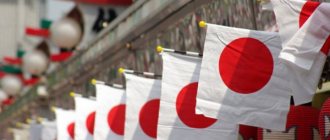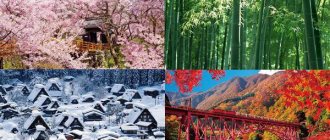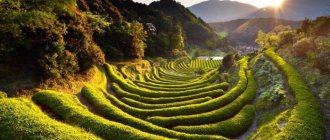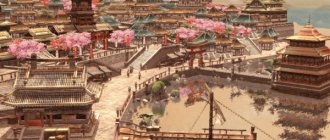Interesting facts about Japan
Ancient traditions
There are traditions in Japan that are several hundred years old. One of these services is presented in modern salons. Quite decent Japanese come to the establishment to be tied up, beaten, and have their cigarettes put out on them after a day of work. Other visitors will watch the process and drink alcoholic beverages. The Japanese often justify such fun with samurai culture.
Kanamara Matsuri
Japan is one of the few countries where they seriously celebrate a holiday in honor of the phallus. The Kanamara Matsuri festival takes place annually in April. On this day, Japanese of all ages walk down the street with large phalluses of different colors. The holiday should help everyone find their soul mate. Souvenirs and correspondingly shaped lollipops are sold on the streets.
Festival of naked men
Another extravagant Japanese custom is the Hadaka Matsuri festival. It takes place in Okayama City in February. On the day of the festival, thousands of naked men come to Saidai-ji Temple. During the procession, men are doused with water, and then temple servants throw special wooden sticks into the crowd. Those who catch them receive good luck for the whole year.
Coffin for fitting
The Japanese are very careful about their death. In many shopping centers you can find funeral shops where you will be offered to think through your funeral in detail while you are still alive. Here you can take a photo at the monument, try on your future coffin and discuss all the details of the burial. Residents of Japan do not want to burden their relatives with such activities.
Nano-crematoriums
Another option for being buried is to use the services of a crematorium, many of which are staffed by Buddhist clergy. One of the most famous such institutions is located in the center of Tokyo in the form of a large capsule. Tourists passing by this building have no idea about its purpose. The most advanced technologies are used here. Upon entering the crematorium, you give the number of the cell with the ashes, which are delivered to the privacy room. If necessary, you can light aromatic incense in the room.
Capsule hotels
In Japan you will find a wide variety of hotels to suit every taste. Often travelers with small budgets prefer so-called “capsule hotels”. The Japanese are accustomed to saving space, and the creation of such hotels is a very good way to inexpensively accommodate a large number of guests. They only provide sleeping accommodations. Moreover, the capsules have a TV, radio and even an alarm clock. Just remember, you must always take off your shoes in Japanese hotels.
State
The form of government in Japan is monarchy. The head of state is the emperor, and he is the only ruling emperor in the world. Emperor Akihito now rules Japan, and he is already the 125th ruler in Japanese history. The imperial dynasty of Japan is the oldest in the world; it has not been interrupted for many centuries, and the country itself does not know revolts against the ruler. This happens because the Emperor of Japan is considered a descendant of the gods, and rebelling against him means blasphemy, which is extremely unacceptable to the devout Japanese. Interesting facts about the country: the emperor is also a spiritual leader; he is the high priest of Shintoism, a religious movement widespread throughout the country. The emperor is not a real political force; the prime minister and government rule on his behalf. However, it performs important religious and representative functions.
The Japanese love baseball very much.
Japan is famous for the fact that, despite observing its own cultural traditions, it has borrowed a lot from foreign cultures. In 1873, Americans came to Japan for the first time to participate in an exhibition baseball game. The game took place at one of the universities in Tokyo, and was led by an American named Horace Wilson. Since then, baseball has become one of the most popular sports in the country.
Almost all schools and universities in Japan have their own baseball teams that participate in leagues and try to get on the podium. Baseball matches attract large numbers of viewers when broadcast on the country's sports channels.
Interesting places for tourists to visit in Japan
Sagan bamboo grove
Japan is proud of its bamboo grove - a green paradise among urban buildings. The trees occupied about 16 square kilometers, this area is protected by UNESCO. In the forest you can ride a bicycle, listen to the sound of a bamboo grove, and look at the temple complexes near the Sojen pond. According to Japanese legends, bamboo protects against evil spirits.
Location: Ukyo Ward.
How to get there: by bus No. 93, 28, 11; by tram JR Senin Main Line; by train from the central station from Shiyo-Omiya terminal to Sagaarashiama.
Get directions
Kusatsu Hot Springs
Japan is a seismic hazard zone, there are a lot of volcanoes. But the long-standing traditions of the Japanese say that a volcanic eruption is a common thing and even useful from a medical point of view. In Kusatsu, natural phenomena are associated with geysers. One of the largest is Yubatake. During active periods, it spews up to 4000 liters per minute.
Address: Kusatsu-machi, Agatsuma County 377-1711, Gunma Prefecture.
How to get there: Take the train from Ueno Station (Tokyo) to Naganohara-Kusatsuguchi and then take the JR bus to Kusatsu Onsen.
Night Tokyo
Tokyo's nightlife is quite vibrant. After the end of the working day, a large number of Japanese go out into the streets to take a break from work and enjoy communication with other people.
Kabukicho
For this purpose, you can go to the vibrant nightlife district called Kabuki-cho. It is located in the Shinjuku area and is completely unremarkable during daylight hours. At night, active life begins here, making it famous throughout the world.
The area begins to glow with neon signs and the streets become very noisy. A huge number of barkers and painted, half-naked women appear near buildings with a dubious reputation.
Golden Guy
The Golden Gai district, located inside Kabukicho, consists of several short and fairly narrow streets. There are a large number of bars open here, some of which can accommodate only 5 people at a time. In appearance, the small cabins resemble carriage compartments and convey the atmosphere of antiquity.
Omoide Okoho
The Omoid Okoho area, located near Shinjuku Station, plays a large role in Tokyo's nightlife. This is a fairly small narrow alley with a huge number of bars open on it.
In addition to Japanese cuisine, you can try various dishes from other countries of the world. The alley has a unique, authentic atmosphere.
Fashion
The style of Japanese clothing is usually associated with the national kimono and the ethnic elements present in the clothing. Back in the middle of the 19th century. In Japan, youth, individual and original clothing began to appear.
Modern youth prefer to wear street style, which is expressed by shocking and brightness. Certain subcultures have begun to emerge that unite young people into small groups.
The largest of them:
- Harajuku;
- Ganguro;
- Lolita;
- Cosplay;
- Kawaii.
Quite often, young Japanese girls dress in such a way that they look like dolls in bright and flashy clothes. A mandatory attribute of their outfit are small handbags that look like soft plush toys.
In Japan, national traditions are respected by absolutely everyone, regardless of age. In fairness, it should be noted that the younger a person is, the more he absorbs and uses modern European gestures and behavior.
This also applies to wearing the famous Japanese kimono or wafuku. Previously, the Japanese always wore their national costume; today they wear it exclusively for celebrations or when welcoming a welcome guest.
Author: Olga Zhanskaya
Tokyo metro
The Tokyo Metro, founded in December 1927, serves 8.8 million people daily. On average, it ranks 2nd in the world in terms of passenger traffic. Key metro stations are connected to other public transport systems, making using the metro as convenient as possible.
In total, the Tokyo Metro network consists of 158 lines, 48 operators, 4,714.5 km of railway tracks and 2,210 stations.
Tokyo subway cars
The Tokyo Metro carriages are as comfortable as possible; the seats installed in the carriages are equipped with a heating function. In addition to Japanese, train stops are announced in English and sometimes in Chinese.
Interesting facts about the Japanese subway:
- In Japan, there is a very original profession that is associated with the subway, it is called “oshiya”. This special person is responsible for physically dragging passengers into overcrowded carriages.
- The Tokyo Subway does not have safety chutes.
- Talking on a mobile phone at a metro station and in carriages is considered a sign of bad taste.
- All platforms have drinking water dispensers and toilets.
- All stations are decorated in a minimalist style and have no architectural flourishes.
- The metro rolling stock consists of 10 cars.
- The last metro car during the busiest hours is intended exclusively for women in order to protect the weaker half of humanity from harassment by men.
- The cost of a metro trip directly depends on the distance of the trip.
- All metro stations have their own serial number and trains run exclusively on schedule.
Festivals
In Japan, various festivals are held with enviable regularity, which attract a huge number of people from different cities of the world:
- Fireworks Festival on the Sumida River in Tokyo;
- Shinjuku Eisa Matsuri in Tokyo;
- Fukawa Matsuri in Tokyo;
- Azabu-juban Matsuri;
- Koenji Awa Odori in Tokyo;
- Soma Nomaoi in Fukushima;
- Aomori Nebuta Matsuri in Armory;
- Sendai Tanabata Mashiri in Miyagi;
- Kyoto Gozan Okuribi in Kyoto;
- Kishiwada Danjiri Matsuri in Osaka.
The Japanese love to kill themselves
The Japanese are very disciplined and hardworking people. They highly value spirituality and have a philosophical approach to life. However, Japan has a bad reputation as a country with one of the highest rates of suicide among its population in the world. Every year up to 30 thousand people dare to commit suicide.
Such statistics forced the Japanese authorities to think about measures to suppress such incidents. There are many reasons for suicide in Japan: severe persecution in schools and bullying, depression, taking work too seriously and everything connected with it. Having lost his job, the average Japanese may lose the meaning of life.











